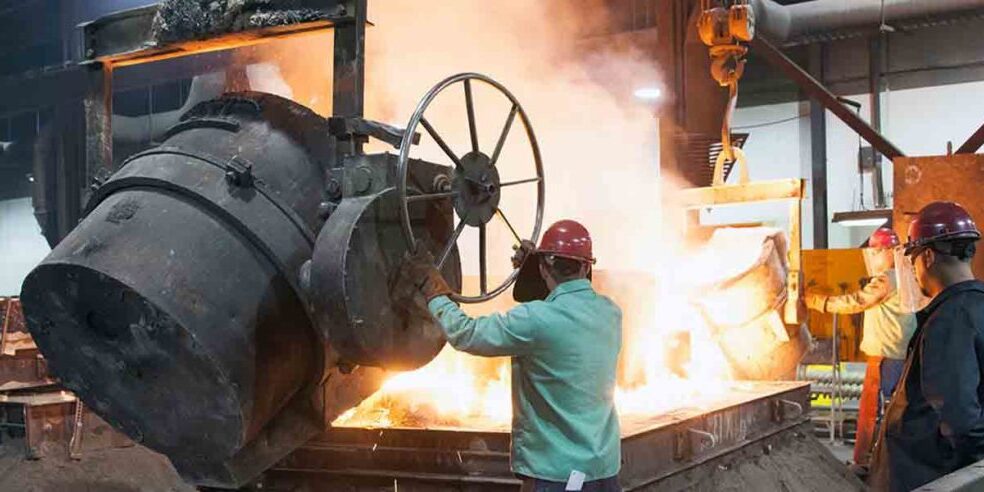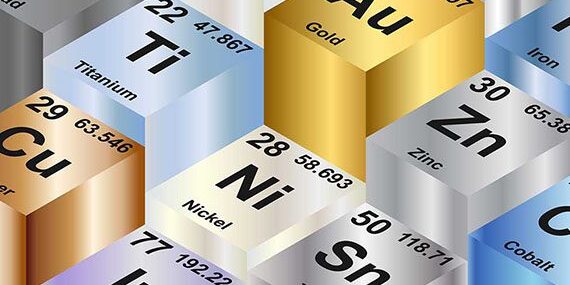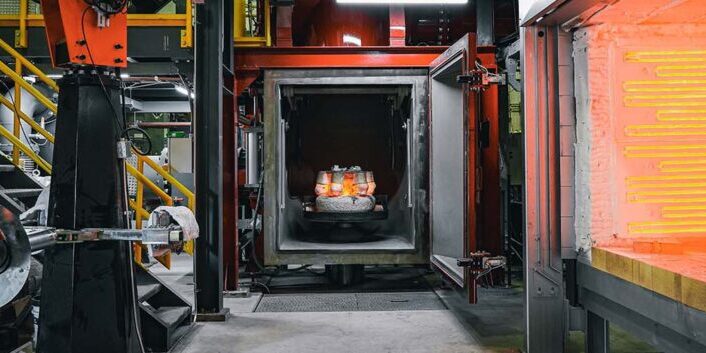Blog 8 Metals Commonly Used For Casting
Metal casting involves pouring molten metal into a die or mold to form a desired shape. Numerous types of metal casting exist, including investment, sand, centrifugal, and die. Metals are chosen for metal casting methods based on their characteristics such as corrosion and wear resistance, tensile strength, hardness, machinability, and cost. Here are eight commonly used metals in casting and the reasons for their use.
Carbon Steel
Carbon steel has carbon at percentages ranging from .5 to 2.1%. Higher carbon content improves hardness and strength via heat treatment and a lower melting point. However, the tradeoff is reduced ability for weldability. Carbon steel is versatile and economical, making it great for general engineering and structural applications.
- Properties
- High tensile strength
- Great toughness
- Durable
- High machinability and ductility
- Even heating capabilities
- Cost-effective compared to stainless steel
- Common Applications
- Construction components
- Machinery parts
- Cutting tools
- Automotive parts
- Wrenches and hammers
- Industrial equipment where strength and wear resistance are critical
Stainless Steel
Stainless steel is an iron alloy that is highly resistant to rusting and corrosion, mainly due to the addition of chromium. Specifically, stainless steel must contain a minimum of 10.5% chromium, creating the protective oxide layer. There are over sixty different grades of stainless steel, and unique ones are still added. A complete breakdown of steels can be found in our What Are Ferrous Alloys blog.
- Properties
- Corrosion resistance
- High strength
- Toughness
- Excellent heat resistance
- Suitable in harsh environments (heat, cold, acidic) and hygiene applications
- Common Applications
- Chemical processing equipment
- Pumps & valves
- Heat exchangers
- Bearings
- Impellers
- Housings
- Pressure vessels
- Food & beverage equipment
- Medical devices
- Tool manufacturing
Nickel-based Alloys
Nickel-based alloys are combined with copper, iron, chromium, and titanium. Due to the superior oxidation layer created, they often perform better in extreme working environments, such as those in the aerospace, chemical, and petroleum industries. The MetalTek blog has a complete guide to nickel-based alloys.
- Properties
- Exceptional heat resistance
- Corrosion resistance
- Strength at elevated temperatures
- Common Applications
- Turbine engine parts
- Aerospace components
- Chemical processing equipment
- Heat exchanges and industrial furnaces
- Calciners
- Marine parts
- Food & beverage equipment
- Medical equipment
Copper-based Alloys
Copper-based alloys have copper as the base component. The more common alloys created are bronze and brass via varying zinc levels. You can learn all about the various alloys and details that distinguish them via our Copper Base Alloys Guide.
- Properties
- Excellent thermal and electrical conductivity
- Corrosion resistance
- Good machinability
- Non-magnetic
- Excellent of mechanical and electrical properties in cold temperatures
- Common Applications
- Bushings
- Bearings
- Wear rings
- Gears
- Pumps & valves
- Marine propulsion
- Electrical components
- Plumbing fittings
Grey Iron
Grey iron is known for its grey color, which comes from the graphite flake structure created during the carbon’s cooling process. The color is from both the alloys and the casting process. The mechanical properties of great iron are determined by the size/shape of the graphite flakes in the microstructure of the cast. Grey cast iron is popular for casting due to its inexpensive nature.
- Properties
- High compressive strength
- Good machinability
- Brittle and less hard
- Great damping capacity
- Thermal conductivity
- Common Applications
- Pump housings
- Gears and valves
- Hydraulic parts
- Automotive engine blocks
- Manhole covers
- Machinery bases
White Iron
White iron has a white crystalline fracture structure made of the compound cementite. Unlike grey iron, white iron is typically free of graphite. White iron is not the easiest to cast as its solidification temperature is much higher.
- Properties
- High hardness
- Wear resistance
- High compressive strength
- Strength at elevated temperatures
- Common Applications
- Crushers
- Grinding balls
- Coal pulverizes
- Mill liners
Ductile Iron (Nodular Iron)
Ductile iron is a cast iron best known for its spherical graphite structures in the metal. The ductility of this iron allows it better flexibility and holds up under stress without breaking or cracking. Ductile iron is made by adding considerable amounts of carbon. Several elements are added, but magnesium specifically reduces the amount of sulfur in the iron, thus making it less brittle. Graphite also helps with improved wear resistance. Ductile iron is stronger than grey iron.
- Properties
- High tensile strength
- Good ductility
- Impact resistance due to the spherical graphite nodules
- Excellent wear resistance
- Common Applications
- Automotive components
- Hydraulic parts
- Machine tooling
- Pipe and pipe fittings
- Heavy-duty machinery components
- Critical structural and load-bearing components
Aluminum Alloys
Adding aluminum to the alloy mix improves strength, workability, and corrosion resistance. It is also lightweight, making it an excellent alloy for applications where weight is a concern.
- Properties
- Lightweight
- Good corrosion resistance
- High strength-to-weight ratio.
- Common Applications
- Automotive parts
- Aerospace components
- Boat and ship parts
- Railway parts
- Electronics
- Consumer goods
To wrap up the eight key metals, here is chart summarizing key properties for each of the metals. This is a great comparison guide as you look to kick off a project and understand which metal or alloy is a best fit.
| Carbon Steel | Stainless Steel | Nickel-Based Alloys | Copper-Based Alloys | Grey Iron | White Iron | Ductile Iron | Aluminum | |
| Corrosion Resistance | Low | High | High | High | Low | Low | Low | Medium |
| Wear Resistance | Medium | Low | Low | High | High | High | Medium | Low |
| Tensile Strength | Medium | Low | Medium | Low | Medium | High | Medium | Low |
| Hardness | Medium | Low | Medium | Low | High | High | High | Low |
| Machinability | Medium | Low | Low | High | High | Low | High | High |
| Price | Low | High | High | Medium | Low | Low | Low | Medium |
MetalTek experts can guide you on your next metal casting project. This is a high-level overview of the alloys and metals, but there are countless alloys to pick from, and we can help you navigate through the extensive alloy collection. Contact us today to begin your project.



